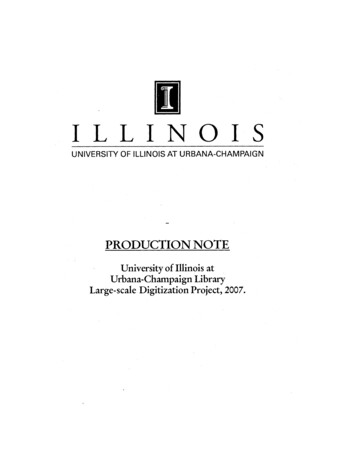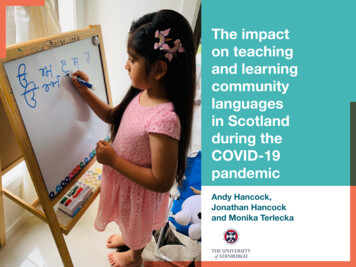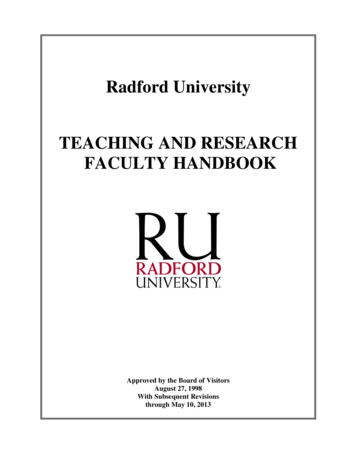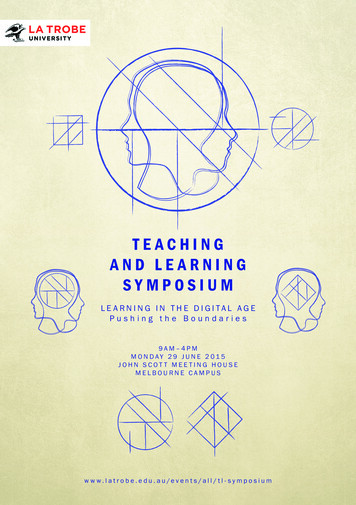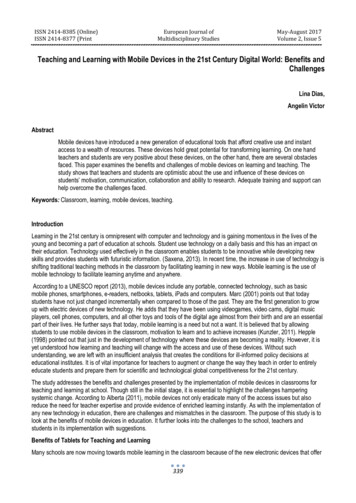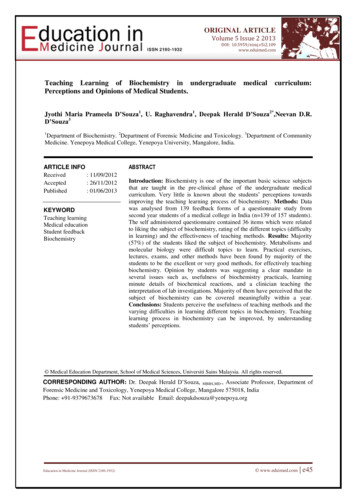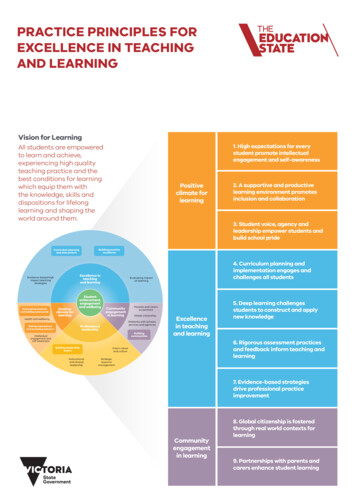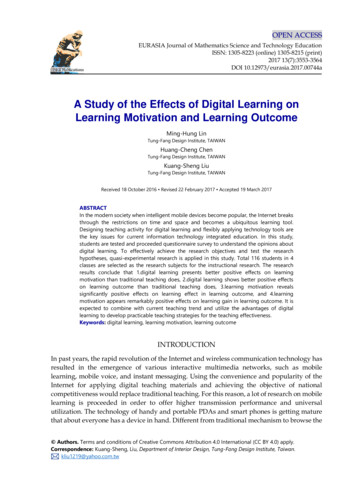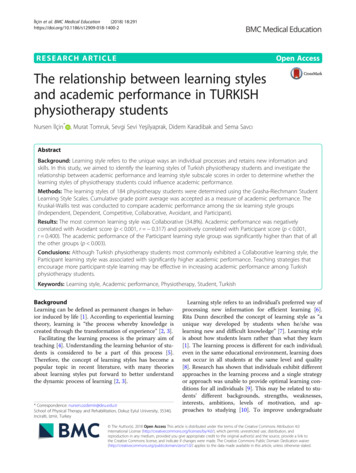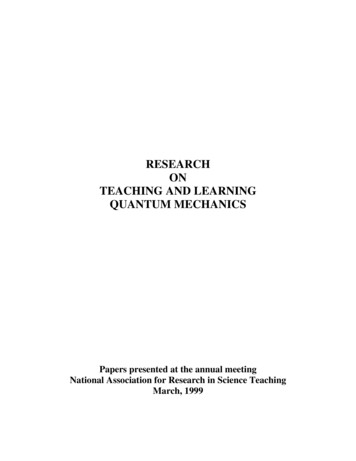
Transcription
RESEARCHONTEACHING AND LEARNINGQUANTUM MECHANICSPapers presented at the annual meetingNational Association for Research in Science TeachingMarch, 1999
TABLE OF CONTENTSIntroduction1Dean ZollmanConceptual Understanding Of Quantum Mechanics After Using Hands-On AndVisualization Instructional Materials2N. Sanjay Rebello & Dean ZollmanHow Computer Simulations Affect High School Students' Reasoning In QuantumChemistry7Charles L. Hurwitz, Gerald Abegg & Peter GarikUsing Computer Visualization Software To Teach Quantum Science: The Impact OnPedagogical Content Knowledge11Karen M. Robblee, Peter Garik &Gerald AbeggStudents' Views of Models and Concepts in Modern Physics15Manfred Euler, Markus Hanselmann, Andreas Müller &Dean ZollmanStudents’ Conceptions of Quantum Physics.20Rainer Müller and Hartmut WiesnerEvaluation of a New Approach in Quantum Atomic Physics in High School23Hans Niedderer & Stefan DeylitzQuantum Mechanics : Exploring Conceptual Change28Peter Fletcher & Ian JohnstonIntroduction to Quantum Physics -Development and Evaluation of a New Course32Helmut FischlerThe influence of student understanding of classical physics when learning quantummechanics41Richard Steinberg, Michael C. Wittmann, Lei Bao, and Edward F. Redish 1999, Each paper is copyrighted by its authors.Printing of this document is supported by the National Science Foundationunder grants ESI-9452782, DUE-9652888.& STI 9620042ii
INTRODUCTIONDean ZollmanDepartment of Physics, Kansas State University, Manhattan, KS 66506 USA,dzollman@phys.ksu.edu"I believe that any lover of nature should study quantum mechanics -- not its mathematics but its ideas."--Douglas HofstadterUntil recently the main purpose for students other than physicists and chemists to study quantummechanics was for a better appreciation of its influence on modern thought. Now people who will bemaking decisions about business and technology need an understanding of modern physics. Recentdevelopments in miniaturization of electronics and nanotechnology bring into the business and engineeringworld devices that can be appreciated only through the principles of quantum mechanics. Likewise, in thepast few years experiments have directly analyzed some of the fundamental paradoxes in quantummechanics. Thus, an understanding of quantum physics beyond the level of a coffee table book is neededfor the well-informed citizens and all types of professional in the 21st Century.As the need for students to understand quantum phenomena increases, so does our need to understandthe learning process for these abstract and counterintuitive concepts. In recent years research in studentunderstanding of quantum science has increased greatly. Some researchers have investigated traditionalmethods of learning, while others have developed and assessed techniques such as hands-on experimentsand interactive computer visualizations. (Generally, hands-on experiments would not be considered nontraditional. However, the usual method of teaching quantum science is with little or no experimentation.)Over the past ten years a small number of researchers have been involved in these efforts. Their work isnow showing some good results that can help us understand how to teach quantum mechanics and, perhaps,other abstract scientific concepts.Most of the studies have concentrated on conceptual understanding of quantum science. The primaryquestion is, Can students learn the ideas of quantum mechanics even if they are not familiar with theadvanced mathematics that forms the basis of the topic? By studying the learning process researchers havebeen able to determine some techniques are effect and some that are not. Modifications in learningmaterials and suggestions for improvements in traditional approaches have been created as a result of thesestudies. At the 1999 Annual Meeting of the National Association for Research in Science Teaching sevendifferent groups who are addressing the learning of quantum mechanics from different perspectives presenttheir findings. Two of the groups have relied heavily on interactive computer visualization and otherminds-on activities. One group has assessed a learning technique that uses a commercial computer problemsolving technique has a foundation. The other three have relied primarily on more traditional approaches tolearning/teaching although they have moved beyond the lecture and textbook. In all cases research datahave been collected about the process. One additional group which was unable to present at NARST isrepresented by a short paper here.As can be seen from these paper, the research of each group is closely related to the others. At the sametime each group’s approach is sufficiently different that their research complements the others. Further,different groups have focused on different groups of students. The students include university-boundstudents in science classes, physical science students in both high school and college and physics majors atuniversities. Thus, the NARST session and these papers provide meeting participants and readers with abroad view of the research and development concerning the learning of quantum science.1
CONCEPTUAL UNDERSTANDING OF QUANTUM MECHANICS AFTERUSING HANDS-ON AND VISUALIZATION INSTRUCTIONAL MATERIALS*N. Sanjay RebelloDepartment of Physics, Clarion University of Pennsylvania, Clarion, PA 16214 USA,srebello@clarion.eduDean ZollmanDepartment of Physics, Kansas State University, Manhattan, KS 66506 USA,dzollman@phys.ksu.eduABSTRACTMaterials developed by the Visual Quantum Mechanics project teach some basic ideas of quantummechanics to high school and introductory college students by integrating hands-on activities and computervisualization. During field tests of the materials we obtained data concerning student understanding ofsome quantum concepts including potential energy diagrams, energy levels and spectra in atoms, energybands in solids, wave functions and probability, and quantum tunneling. Data were collected from writtenresponses of students structured interviews and a concept map. While a few misconceptions persist, theoverall results indicate that students seem to have acquired a good general understanding of some importantconcepts that are usually not taught at the introductory level.INTRODUCTIONThe physics curriculum in most high schools and introductory college courses contains, at best, a passingreference to 20th Century physics. Hence, students often do not see the topics of interest to contemporaryphysicists, the contribution of physics to modern thought or the connection between the physics they learnand modern technology. This lack of exposure can result in a lack of interest in physics.The Visual Quantum Mechanics (VQM) project makes quantum mechanics and related topics accessibleto high-school and introductory college students by minimizing the use of mathematics in its presentation.Instead, hands-on activities, computer visualizations, and written worksheets are integrated in an activitybased environment. (Zollman, 1999) We utilize the Learning Cycle instructional model (Karplus, 1974).Students begin by exploring a modern device Light Emitting Diode (LED). They realize that they cannotexplain the device’s operation by using any existing metal models and therefore must construct new modelsto explain their observations. Subsequently, they apply these mental models in a different situation.INSTRUCTIONAL MATERIALSThe curricular materials are organized into instructional units that can each be completed in about 6-12hours of classroom instruction. The units can be integrated into an existing curriculum since theprerequisites are topics covered in a standard physics curriculum. The instructional units are:Solids & Light Students use LEDs and gas lamps to understand the concepts of energy levels andenergy bands, transitions, and spectra.Luminescence: It’s Cool Light Students utilize fluorescent and phosphorescent materials to understandthe effects of impurities on energy bands and on the creation of metastable states. Some overlap existsbetween this unit and the Solids & Light unit.The Waves of Matter Students explore the creation of a model to explain the discrete energy states.Applying aspects of the model to the Star Trek transporter and the electron microscope students learn aboutthe wave nature of particles, wave functions, Schrödinger equation (qualitatively) and wave packets.Seeing the Very Small: Quantum Tunneling Using a simulation of the Scanning Tunneling Microscope(STM) as the pedagogical vehicle students learn about quantum tunneling and the factors that influence it.Early in project we realized the need for two units that would address lacunae in a traditional curriculum.Potential Energy Diagrams These diagrams are powerful representation that is utilized in quantummechanics. We use magnets placed on a Pasco dynamics and along the track or Hot Wheels cars to createand explore potential energy diagrams of different shapes. (Jolly, et al. 1998)*This work is supported by the National Science Foundation under grants ESI-9452782, DUE-9652888.& STI 96200422
Making Waves This unit treats classical waves and introduces just those concepts that are needed forthe study of The Matter of Waves unit.Prior to the present study all VQM units were field-tested at numerous high schools and colleges inseveral states. Revisions had been completed based on the field tests.PROCEDURES FOR THE STUDYStudentsThe students were enrolled in Contemporary Physics at Kansas State University. This course is offeredfor students who are planning to be secondary science or mathematics teachers, but have an area ofconcentration different from physics. If this one-semester course is taken after they have completed oneyear of introductory physics, it meets the requirement for the students to become certified to teach physics.In addition, some students enroll in the course to fulfill a general education requirement in the physicalsciences. These students have completed a one-semester physics course for non-science students. Thus, all17 students in this class during the Spring Semester, 1998, had taken at least one semester of introductoryphysics prior to enrolling in Contemporary Physics. However, the level of reasoning and mathematicalskill in the students’ previous physics course varied greatly. Contemporary Physics was taught in mannerwhich integrated lecture, discussion, hands-on experiments and interactive computer activities. Thestudents worked in small groups with the hands-on and computers activitiesPropose of the studyIn this study we examined the level of understanding the students gained from their conceptual study ofquantum phenomena. We attempted to ascertain what level of understanding the students reached duringtheir semester of study and what areas of quantum physics provided the most conceptual difficultEvaluation InstrumentsNo established instrument for measuring students’ conceptual understanding in quantum mechanics ormodern physics, similar to those that exist in mechanics was available. Further, since this material is notusually taught in the traditional format, we could not compare our results in student understanding withthose from alternative materials or approaches. Thus, results are based on student responses to questions onactivity worksheets, examinations, interviews conductor by one of us (NSR), and a concept map which thestudents drew at the end of the semester.RESULTSBecause of the small number of students in the study and the type of data available, we did not perform astatistical analysis on the data. Instead, we analyzed the various data sources to uncover trends in thestudents’ thinking and successes and difficulties in the conceptual understanding.Representation of an AtomWe have assiduously avoided the use of the Bohr model of the atom in all our representations. Rather wehave focused on the energy diagram representation. This representation is introduced to students in theSolids & Light unit and expanded in the Luminescence unit, after they have observed the spectra of gasesand studied potential energy diagrams of a cart on the track.We found that most students do not relinquish the previously learned planetary model of the atom. Thereis also considerable confusion in students’ minds about whether the energy level represents the total energyor the potential energy of the electron. This confusion is reflected primarily in students’ inability tocorrectly determine the binding energy of an electron in a particular energy level.In using the potential energy diagram model of the atom, most students mistake the vertical axis in thediagram as representing the physical distance of the corresponding energy level from the nucleus, whichthey believe is located at the center of the bottom of the rectangular potential well. In spite of thesemisconceptions, however, they are correctly able to predict the dependence of the shape (depth and width)of the potential energy diagram on the nuclear chargeEnergy Levels & SpectraStudents construct the energy level model of an atom after observing the spectra of gases in the Solids &Light unit. At this time in their studies, the students are observing spectra as an empirical result. Whilethey may draw an atom as a Bohr model, almost none of them remember its connection to the spectrum ofhydrogen. Essentially, none of them have learned about wave functions, probabilities or applied standingwaves to bound states. Using their knowledge that light is a form of energy and that the atom emits only3
specific energies of light, students come to understand that the atom can have only certain values of energy-- discrete energy levels. Students are, thus, able to use empirical data to grasp one of the fundamentalconcepts of quantum physics.Part of the study of energy levels requires the students to construct energy level diagrams to explain thetransitions in the atom. In the initial stages of our development we observed that students would assignidentical energies to a spectral line to an energy level. For example, if a gas had 3 spectral lines of energies1.8eV, 2.1eV and 3.0eV, students would construct an energy diagram that had the levels at each of theseenergy values. This model is incorrect, since each spectral line is related to a transition between energylevels and not the energy levels themselves.We designed the Gas Spectroscopy Lab program to enable students to overcome this difficulty inunderstanding. (Rebello, et al. 1998) In the program students construct a trial spectrum to match a givengas spectrum. The trial spectrum depends upon the energy differences and transitions created by thestudent. The program confronts directly the issue of whether the energy of the light is related to the energylevels or energy differences. After using this program almost all students are able to overcome their earlierlearning difficulty. Many students draw an energy level diagram with all transitions starting at one energylevel and changing to different energy levels with the energy differences corresponding to the energies ofthe spectral lines. For hydrogen, of course, this energy level diagram is inaccurate because the visible linesare created when electrons move from various states to the n 2 state. However, the students do not havethat information available unless they remember from a previous course. When asked explicitly whethertheir energy level diagram is the only possible answer, most students reply that other energy level diagramsare also acceptable, and that it is the difference between the energy levels that is crucial rather than theenergy values themselves. We believe that students realize this because they are specifically asked tocompare the energy level diagram of their group with those of other groups in class.In an interview, students were asked to explain whether the fact that a given spectrum could beconstructed by a non-unique set of energy levels contradicted the fact that this spectrum was unique to agiven gas. Most students do not see a contradiction between these two ideas.Energy Bands in SolidsMost students can “discover” the energy band model for a solid when they are asked to create anacceptable set of energy levels to explain the continuous spectrum of an LED. They are also able to predictthe spectrum and turn-on voltage of an LED given its energy band diagram. Some students, however,relate the turn-on voltage to the energy gap rather than the energy difference between the P and N sides ofthe LED. (Rebello, Ravipati,, Zollman & Escalada, 1997)To see how well the students had understood energy bands and gaps, we asked them to apply theseconcepts to a device which can detect infrared light. This device is a small solid strip which can bepurchased at electronics stores such as Radio Shack. When infrared light is incident on the strip it emitsvisible light. Thus, the solid is converting relatively low energy light (IR) into higher energy visible light.Before being asked to explain the device in terms of energy bands and gaps, the students completed a seriesof experiments which would help them build a model. Most students had difficulty creating a model of aninfrared detector using energy levels, bands, and transitions. However, we should not be surprised. Inworkshops involving research physicists we have observed some of the same difficulties.Wave Functions & Wave PacketsThe wave nature of particles is “discovered” by students when they compare an electron diffractionpattern (real and computer simulated) with that of light from Young’s double slit experiment. By slowingdown the formation of a computer simulated electron diffraction pattern in a simulation and asking studentsto predict where an electron (represented by a bright spot) will be visible on the screen, we have themconstruct the probabilistic model of an electron. The wave function is then presented as a graphicalrepresentation of the electron, which when squared gives the probability density function.Students can sketch the probability density function from the wave function and vice-versa, but do notcompletely understand the relationship between probability and probability density.Although most students are clear that the wave function is not the path of the electron, when asked tosketch the wave function of an electron beam in a tube (experimental set up for the e/m experiment), mostof them sketch a static sinusoidal wave. A few students believe that this picture is a snapshot at a giveninstant of time, and would travel as the electron traveled down the tube.In The Waves of Matter unit, students learn the relationship between the wave function and the potentialenergy diagram. They are also expected to learn the reason why the wave function model concludes that4
only certain energies are allowed in an atom. Without learning the mathematical formalism of theSchrödinger equation, students are introduced to various scenarios that result in sinusoidal and decreasingwave functions. Students are quite successful in applying the criteria for sketching wave functions fordifferent shapes of potential energy diagrams. When students observe the diverging wave functions in theBound States program (Figure 1), they are unable to relate these to the disallowed energy levels in an atom.Students are introduced to wave packets created by adding waves functions each representing a particlewith a different momentum. TheUncertaintyPrincipleisintroduced by demonstrating thata larger spread in momentumvalues results in a morecompressed spatial wave packet.Students also use a simulationshowing the time evolution of aspatial wave packet.Moststudents, however, are unable toapply the Uncertainty Principle torelate the increasing spatial spreadto an increasing certainty in theFIGURE 1: Bound States Program demonstrates a divergingmomentum of the particle. On thewave function for a disallowed energy level.positive side these students do notidentify the Heisenberg Principlewith a difficulty in measurement or with momentum transfer of from a photon to an electron. This teachingtechnique seems to help them understand that the Uncertainly Principle arises because of the wave behaviorof matter. In this respect they have a better understanding than many physics students.Quantum TunnelingStudents learn about quantum tunneling by exploring a computer simulation of a scanning tunnelingmicroscope (STM). (Rebello, Sushenko & Zollman. 1997) The STM uses quantum tunneling to collectinformation about a surface without physical contact with it. Tunneling is a natural consequence ofcorrectly applying the criteria for sketching wave function for a barrier. Given the tunneling probability ofan electron, most students are successfully able to sketch the wave function, including the relativeamplitudes of the oscillating wave functions on both sides of the barrier. They are also able to predictcorrectly how this wave function would change if the width or energy of the potential energy barrier werechanged. Using the STM Simulator program students learn these relationships in the context of the positionand voltage of the probe tip of an STM.While students successfully apply the concepts of tunneling to an STM, they are unable to extend theseconcepts to the macroscopic world. When asked to explain why the cart in the Potential Energy Diagramsunit could not tunnel through the barrier, most of them incorrectly reason that the cart did not tunnelbecause the total energy of the cart is less than the potential energy of the barrier. That this in fact, is anecessary condition for tunneling alludes most students. A few students, however, correctly respond thatthe cart does not tunnel because its de Broglie wavelength is much smaller than thickness of the barrier.Overall Concept MapAt the end of the semester, each student was asked to draw a concept map relating various concepts thatthey had learned in the course. 10 students (Group I) were asked to create a list of concepts by themselves.The remaining 7 students (Group II) were provided with a list of over 50 concepts/words. Both groupswere provided with some written instructions and an example of a concept map.The concepts can be grouped into 12 concept clusters. In general the concept cluster maps from bothgroups are fragmented with most connections shown only between topics that are in the same instructionalunit. Fragmentation was more severe in Group II, although the maps in that group better matched theinstructor’s expectations. Most maps did not show a central theme. Connections between “Energy Levels”and “Wave Functions”, or “Schrödinger Equation” and “Wave Functions” were absent in most maps.There is no correlation between the richness of the concept map drawn by a student and her/hisperformance on related exam questions.5
CONCLUSIONSThe goal of the Visual Quantum Mechanics project is to enable students who have little science ormathematical background. The emphasis in placed on conceptual learning and visualization in place ofmathematical rigor. In the present study we attempted to ascertain which concepts have been madeunderstandable to a group of students with a broad range of previous experiences in science andmathematics. The analysis at present is preliminary, so we have not yet attempted to correlate the students’level of understanding with their previous experience. Instead, we have looked for over all patterns andtrends. In doing so, we have identified those concepts which seem to cause the students more difficultythan others have in reaching an acceptable level of understanding.Overall, we observe that hands-on activities, computer visualization programs and constructivistpedagogy enable our students to build mental models which explain their observations. For example, theempirical approach seems to be quite effective in helping students come to a conclusion about the discretenature of energy levels in atoms. Likewise, students are able to move readily form the energy levels ingases to the energy bands and gaps in solids – again by taking an empirical approach. They are also able tounderstand the limitations on their energy models and when more than one model is possible. Many of thebasic features of wave functions also became understood by most of the students. In particular, the studentswere able to grasp the empirical reason for the necessity for matter waves and wave functions after theyhad explored the interference effects of light and of electrons. They could also relate probability to wavefunctions and understand the relationship between standing waves and the discrete energy levels in atoms.Thus, many of the basics of quantum physics seem to be able to be understood at a qualitative level bythese students.At the same time the subjects in this study had difficulty with some concepts which the authors think arepresented equally well. In particular, expanding the energy band and gap model to a device that displays arather perplexing behavior (absorbing low energy light and emitting higher energy light) was beyond thereach of many students. Likewise the reason why quantum tunneling should be considered surprising(form the classical physics viewpoint) was not fully appreciated. Others and we have observed difficultieswith some of these same issues in students with much stronger physics background. (Johnston, Crawford,& Fletcher, 1998; Petri & Niedderer, 1998: Euler, et al, 1999)This preliminary study provides us with information about the relative difficulty in helping students learnabstract concepts through hands-on activities and computer visualizations. It also can point the way toways in which we can improve the learning of quantum physics for more advanced students. Presumablythe concepts which gave our students the most difficulty at the conceptual level are those that will requirethe greatest effort in teaching and learning for students who are attempting to understand both theconceptual and mathematical aspects of quantum physics. Thus, we intend to build on this foundation withfuture studies of student learning of quantum phenomena at all levels.REFERENCESEuler,M., Hanselmann, M., Müller, A. & Zollman, D (1999) Students' Views of Models and Concepts inModern Physics, this paper set, NARST Annual MeetingJolly, P., Zollman, D., Dimitrova, A. & Rebello, R. (1998) Visualizing Potential Energy DiagramsAmerican Journal of Physics 66, 57-63Johnston, I.D., Crawford, K., and Fletcher, P.R. (1998) “Student Difficulties in Learning QuantumMechanics”, International Journal of Science Education, 20, 427-446Karplus, R. (1974). Science Teaching and the Development of Reasoning. Journal of Research in ScienceTeaching, 12, 213 - 217.Petri, J., Niedderer, H. (1998). A learning pathway in high-school level quantum atomic physics.International Journal of Science Education, 20, 1075-1088Rebello, N. S., Ravipati, C., Zollman, D. A., & Escalada, L.T. (1997) Computer Simulation of P-NJunction Devices American Journal of Physics, 65, 765-733.Rebello, N. S., Cumaranatunge, C., Escalada, L. T. and Zollman, D.A. (1998) Simulating the Spectra ofLight Sources, Computers in Physics 28-33Rebello, N. S., Sushenko, K., & Zollman, D. A. (1997) Learning the Physics of a Scanning TunnelingMicroscope (STM) Using a Computer Program European Journal of Physics 18, 456-461.Zollman D. (1999) Hands-On Quantum Mechanics in the Proceedings of Hands-On Experiments inPhysics Education, GIREP, to be published.6
HOW COMPUTER SIMULATIONS AFFECT HIGH SCHOOL STUDENTS'REASONING IN QUANTUM CHEMISTRYCharles L. Hurwitz, Gerald Abegg &Peter GarikSchool of Education, Boston University, Boston, MA 02215 USA,churwitz@bu.edu gabegg@bu.edu, garik@bu.eduINTRODUCTIONThe focus of this paper is on alternative conceptions in quantum chemistry held by honors students in highschool. The study investigates how an intervention using interactive simulations in quantum chemistryalters student understanding. The researcher compares the effects of traditional methods of instruction, i.e.lecture/lab, against the use of discovery via computer simulation on the alternative conceptions of studentsin quantum chemistry. The researcher observed chemistry students in four high schools prior to, during,and after their use of the Quantum Science Across Disciplines (QSAD) materials which were developed atBoston University, through a National Science Foundation Grant.Student concept maps, and interviews were used to find the baseline misconceptions of the student cohortregarding understanding of quantum science in chemistry. The high school students constructed conceptmaps and were interviewed after the intervention. The student information including concept maps werecoded, and compared to the information obtained from students that exit a class using a more traditionalapproach. As a result of the intervention, high school chemistry students shift to a paradigm that uses theatomic or molecular explanations of quantum chemistry to explain macroscopic phenomena like polarity,and solubility.Students in the experimental classes were required to investigate quantum phenomena using the simulationsand then make presentations. Classmates were encouraged to ask probing questions. Several answersincluded molecular explanations using quantum chemistry to explain measurable phenomena. A Studentbegan to use quantum science when explaining acid strength."The charge density of the molecule shows the degree of polarity in HF. Notice that the chargedensity shifts in favor of the fluorine side of the molecule. The electron cloud still surrounds bothnuclei and therefore indicates that the hydrogen probably does not dissociate as easily as otheracids."As a final example a student trying to explain bond length stated,"You need to calculate the superposition of the wave functions from the nuclei. If the amplitudescancel then bonding is not favored, but when constru
Quantum Mechanics : Exploring Conceptual Change 28 Peter Fletcher & Ian Johnston Introduction to Quantum Physics -Development and Evaluation of a New Course 32 Helmut Fischler The influence of student understanding of classical physics when learning quantum mechanics 41 Richard Steinberg, Michael C. Wittmann, Lei Bao, and Edward F. Redish

